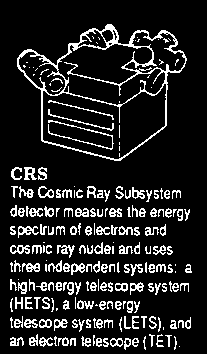Voyager Cosmic Ray Subsystem (CRS)

The CRS looks only for very energetic particles in plasma, and has the highest sensitivity of the three particle detectors. Very energetic particles can often be found in the intense radiation fields surrounding some planets (like Jupiter). Particles with the highest-known energies come from other stars. The CRS looks for both.
The CRS makes no attempt to slow or capture the super-energetic particles. They simply pass completely through the CRS. However, in passing through, the particles leave signs that they were there.
Visit the official Voyager Cosmic Ray Experiment home page.
Science Objectives
-
To measure the energy spectrum of electrons from 3 - 110 MeV.
-
To measure the energy spectra and elemental composition of all cosmic ray nuclei from hydrogen through iron over an energy range from approximately 1 - 500MeV/nuc.
-
To provide information on the energy content, origin, acceleration process, life history, and dynamics of cosmic rays in the galaxy, and contribute to an understanding of the nucleosynthesis of elements in cosmic ray sources.
-
To provide information on the transport of cosmic rays, Jovian electrons, and low energy interplanetary particles over an extended region of interplanetary space.
-
To measure the three-dimentional streaming patterns of nuclei from Hydrogen through Iron and electrons over an extended range.
-
To measure particle charge compostion in the magnetosphere of Jupiter, Saturn, Uranus, and Neptune.
